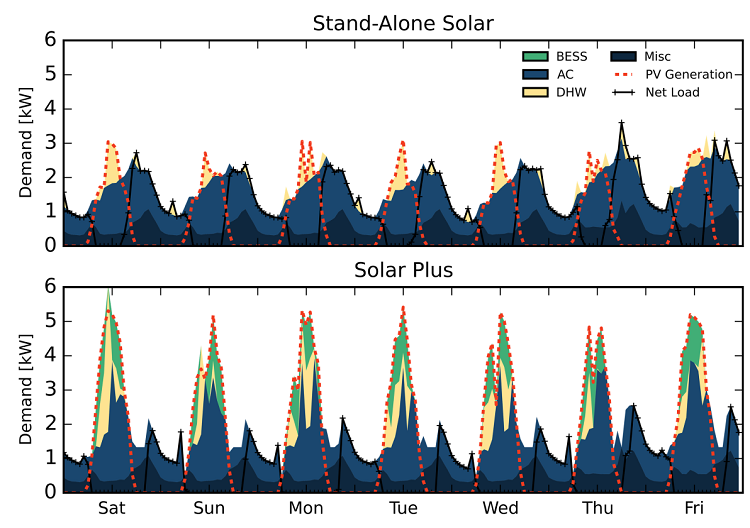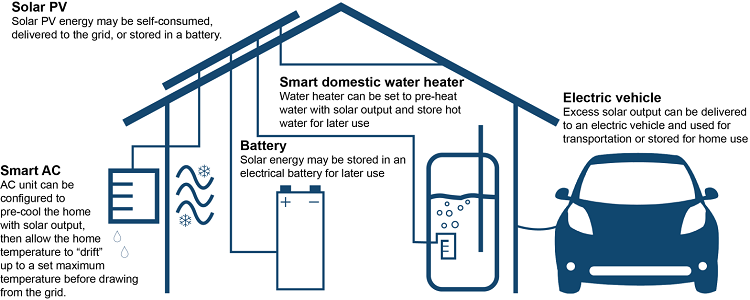REopt Optimizes Residential Solar-Plus Technologies Behind The Meter

REopt compares solar PV and “solar-plus” customer load profiles, grid net load, and solar PV output. Illustration from NREL
The REopt® platform can determine the optimal mix and size of solar photovoltaics (PV) and “solar-plus” technologies to lower the life cycle cost of energy for a number of post-net metering residential utility tariffs (including time-of-use [TOU] and demand tariffs). “Solar-plus” uses solar PV in combination with energy storage and controllable devices—such as smart domestic water heaters, smart air conditioning (AC) units, and electric vehicles—to help customers increase solar self-consumption and realize value from a larger share of their system’s output behind the meter.
For Hawaii’s TOU residential tariff—where no energy export is allowed—the solar-plus approach increases net present value by a factor of three relative to the stand-alone solar PV approach. The smart AC unit and smart domestic water heater are dispatched each day to pre-cool the home and pre-heat water with solar PV output. Any excess output remaining after pre-cooling and water heating is delivered to a battery, which is dispatched to further reduce TOU rates. Customers can use solar-plus technologies to take advantage of excess solar PV output, increasing their cost-optimal system size, reducing system curtailment, and increasing the value of their solar PV system.
The results indicate that the solar-plus approach improves the customer economics of solar PV for tariffs that include demand or TOU components, or for less-than-retail rate net metering. The solar-plus approach may become an increasingly viable model for optimizing solar PV customer economics in a post-net metering environment.

"Solar-plus" technologies combine to increase solar self-consumption. Illustration by Eric O'Shaughnessy, NREL 66299
Related Stories
NREL conference paper: Valuing Energy Efficiency and Distributed Energy Resources in the Built Environment
Applied Energy journal article: Solar Plus: Optimization of Distributed Solar PV through Battery Storage and Dispatchable Load in Residential Buildings
Applied Energy journal article: Solar Plus: A Review of the End-User Economics of Solar PV Integration with Storage and Load Control in Residential Buildings
Solar Plus: A Holistic Approach to Distributed Solar PV:
NREL technical report: Installed Costs and Deployment Barriers for Residential Solar Photovoltaics (PV) with Energy Storage
NREL poster: Optimizing Storage and Renewable Energy Systems with REopt
NREL poster: Optimizing Energy Storage Economics
NREL conference paper: A Statistical Analysis of the Economic Drivers of Battery Energy Storage in Commercial Buildings
Sponsors
Department of Energy Solar Energy Technologies Office
Key Partners
Rocky Mountain Institute
Contact
Share
Last Updated Feb. 11, 2025
